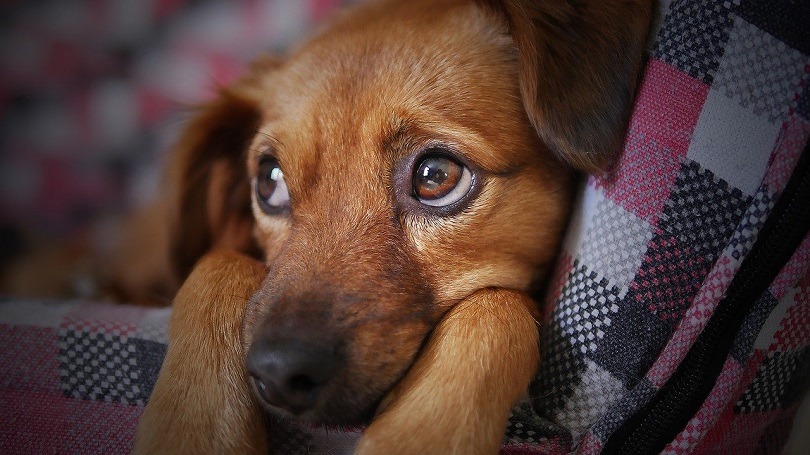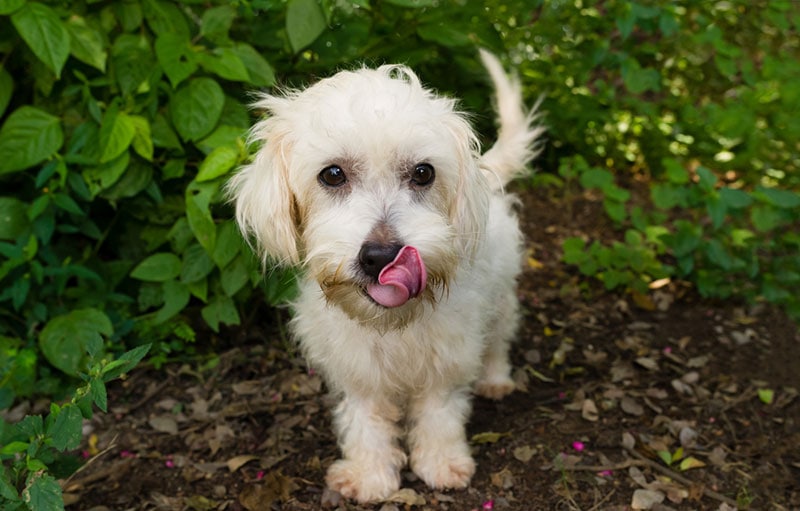Do Dogs Like Eye Contact? Vet-Reviewed Canine Behavior
Updated on

Many people believe that dogs behave similarly to wolves. However, this is often not true. Dogs have evolved next to people for thousands of years. Therefore, they have picked up many behaviors that make them more likable to people (and therefore, more likely to be kept around). In fact, dogs have changed in many ways since being domesticated.
Using parallels between dogs and wolves often doesn’t work. We especially see this regarding things like diet and behavior, including eye contact. It is true that wolves use eye contact to establish dominance. However, this is not the case for domestic dogs. In fact, dogs use eye contact in a similar way to people: to communicate with their friends and bond with them. For instance, studies have shown that playful dogs that want to communicate more with people often make the most eye contact.1 The same is true for breeds bred as companion animals.
We have also discovered that eye contact releases oxytocin (the “feel-good” bonding hormone).2 Therefore, dogs feel good when they make eye contact with their owners and likely use it to strengthen their bonds (unlike wolves). In other words, yes, most dogs do like eye contact.
However, how much eye contact a pup makes with people will vary. It depends on the breed, the individual dog’s disposition, their relationship with the owner, and the owner’s handling.
What Dogs Make Eye Contact?
All dogs will make eye contact. However, some are more likely to make extensive eye contact than others.
Cooperative dogs are the most likely to make extensive eye contact, especially while working. Usually, this includes breeds that were made to work alongside people closely, such as Border Collies and German Shepherds. While working, these dogs make eye contact with their owner to know what to do. Therefore, during training and even play, these dogs are more likely to make eye contact.
Dogs with shorter faces are also more likely to make eye contact. It appears that this is because it is simply easier for them to do so—their nose doesn’t get in the way. However, many short-faced dogs are also companion animals and may be primed to connect deeply with people. Shih Tzus and Pugs were only ever bred to be companions, for instance. It is likely that people would specifically breed for dogs that they connected with deeply, which would probably include eye contact.
Playful and young dogs are also likely to make eye contact regularly. As you might imagine, playing is another way to bond with people. Therefore, if a dog is trying to bond with a person through play, they will likely bond with them through eye contact too.
For one reason or another, mixed breeds adopted from shelters are especially likely to make eye contact according to the previous study. There are many suggestions for why this may be. However, it is possible that the dog’s innate instinct to make eye contact is what got them adopted in the first place.

Is It Okay to Stare at Your Dog?
It is more than okay to stare at your dog. Eye contact makes oxytocin release in both your dog and you. Therefore, it is a vital part of bonding and connecting with each other. While we can’t speak the same language, we do communicate similarly through eye contact and body language.
The common misconception that dogs find eye contact scary comes from the fact that they were once related to wolves. However, dogs have evolved next to people and have been selectively bred for many years, which means their behaviors have changed and adapted to successfully live among us. Therefore, the logic of “wolves do it, so dogs must too” often isn’t true.
You will find many sources across the internet claiming that dogs use eye contact to establish dominance. But this is not entirely true. Eye contact is used with other forms of body language to communicate in different scenarios, and while it can be confrontational at times, that is not always the case.
 Conclusion
Conclusion
Dogs typically make eye contact with people to bond and connect with them. Contrary to common belief, it is not a matter of confrontation or dominance. While wolves sometimes display these behaviors, this is not how dogs act with humans. They have evolved next to people for hundreds of years and learned many of our ways.
Instead, dogs prefer to make eye contact with people often. It releases bonding hormones. In fact, it appears that people also prefer dogs that make eye contact. Therefore, people likely bred dogs that made eye contact from an early time period.
Today, dogs may make eye contact for a variety of reasons. Simple bonding and communication are common ones. Dogs may also make eye contact when working, as they will often keep an eye out for their next command.
Different dogs make eye contact more often than others. Canines with squished noses are more likely to make eye contact, likely because it is simply easier for them to do so. It is also possible that they were bred to make eye contact with people, since many dogs in this category are companion breeds.
- See Also: Do Dogs Like Being Picked Up or Held?
Featured Image Credit: Fran_Mother_Of_Dogs, Pixabay


 Conclusion
Conclusion








